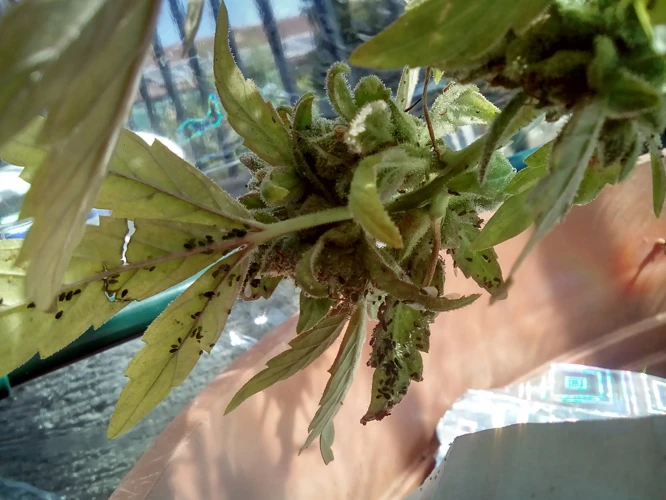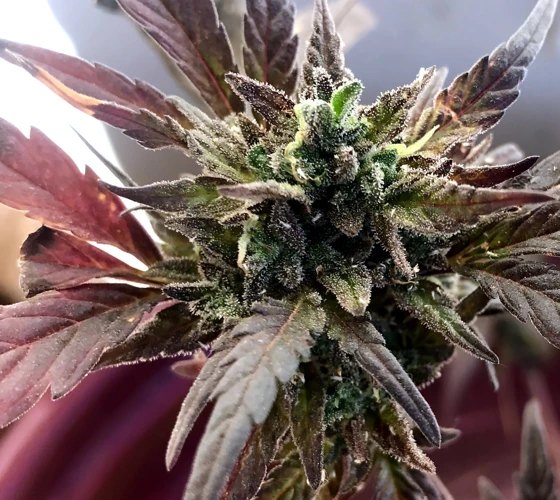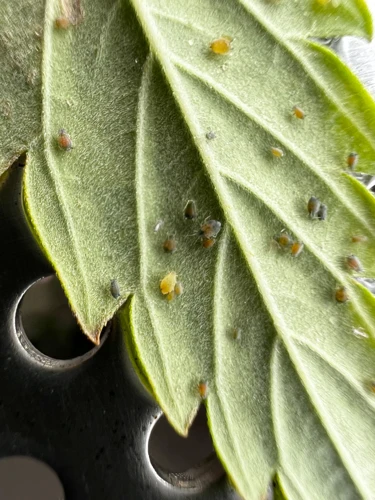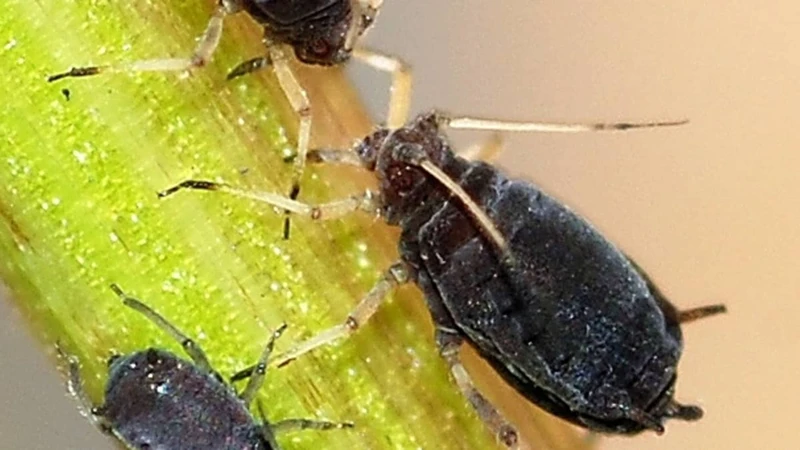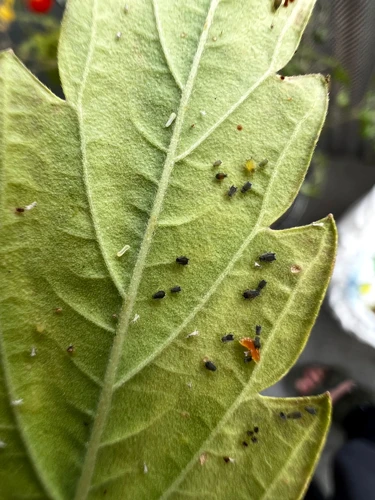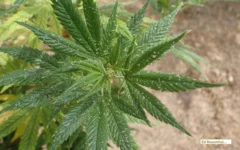
Organic Methods to Control Aphids on Cannabis
Cannabis cultivation can be a deeply rewarding experience, but it also comes with its fair share of challenges. One of the most frustrating problems growers face is the presence of aphids. These tiny, sap-sucking insects can quickly infest a crop, causing a lot of damage if left unchecked. If you’re struggling with an aphid problem in your cannabis garden, don’t despair just yet! There are plenty of organic methods you can use to control these pesky pests and keep your plants healthy and thriving. In this article, we’ll take a detailed look at the identification, life cycle, and effects of aphids on cannabis plants, as well as explore a range of non-toxic sprays and natural remedies you can use to keep these insects at bay. Whether you’re a seasoned grower or a novice, you’re sure to find plenty of useful information and tips to help you control aphids and enjoy a successful harvest.
What are Aphids?
Contents
If you’ve noticed small, pear-shaped insects accumulating on your cannabis plants, you may be dealing with aphids. These tiny pests can wreak havoc on your plants and lead to stunted growth, yellowing leaves, and even the transmission of diseases. Understanding what aphids are, how they impact cannabis plants, and their life cycle is crucial to effectively controlling them. In this section, we will explore the identification and life cycle of aphids in detail.
Identification
Aphids are tiny soft-bodied insects that can be difficult to spot with the naked eye. To identify them, look for these characteristics:
- Size: Aphids are typically less than 1/4 inch in length.
- Color: They can be green, yellow, brown, black, or even red.
- Body shape: Aphids have a pear-shaped body with long antennae and long legs.
- Piercing-sucking mouthparts: Aphids use specialized mouthparts to pierce the plant tissue and suck out sap.
- A sticky residue: Aphids excrete a sugary substance called “honeydew” that can attract other insects like ants and can cause fungal growth on the plant.
It’s important to properly identify aphids because they can easily be mistaken for other insects. If you’re unsure whether or not you have an aphid infestation, take a close look at the characteristics listed above and compare them to pictures of aphids online or in a plant pest guide.
Life Cycle
Aphids have a complex life cycle that consists of several stages, and understanding it is essential to effective control of these pesky insects. Aphids reproduce rapidly, with some species reproducing asexually, which means they do not require a mate to produce offspring. Here is a breakdown of the different stages in the aphid life cycle:
| Stage | Description |
|---|---|
| Egg stage | The egg stage is the initial stage in the aphid life cycle. The eggs overwinter on the host plant or nearby plants and hatch in the spring. |
| Nymph stage | During this stage, the nymphs develop wings and mature into adults through several molts. Nymphs are smaller than adults and have a softer exoskeleton. |
| Adult stage | The adult aphid is the reproductive stage in the life cycle. Females give birth to live offspring, bypassing the egg stage entirely. This rapid reproductive cycle means that populations can explode in a short amount of time. |
Knowing the life cycle of aphids is crucial because it can help you determine the best time to apply control methods. For example, if you know that the majority of the aphids in your garden are in the nymph stage, you can target the nymphs with an organic spray and potentially prevent a full-blown infestation. Additionally, understanding the life cycle of aphids can help you identify the insects on your plants, which is the first step in effective control.
Effects of Aphids on Cannabis Plants
The presence of Aphids in cannabis plants can cause severe damage and negatively impact the plant’s growth and yield. These tiny pests reproduce rapidly and can transmit diseases, posing a severe threat to your cannabis garden. The damage caused by aphids can lead to a weakened immune system and even death in cannabis plants. It is crucial to understand the effects of aphids on cannabis plants to take necessary measures to control their infestation. Let’s delve further into the topic by exploring the physical damage caused by aphids and their role in transmitting diseases to cannabis plants.
Physical Damage
Aphids are tiny insects that can cause severe damage to cannabis plants. They feed on the sap present in the leaves, stems, and flowers of the plant, which can result in wilting, yellowing, and even death of the plant. Physical damage caused by aphids is visible on the plant and can be identified by the following signs:
| Signs of Physical Damage | Impact on the Plant |
|---|---|
| Curled leaves | The plant is unable to carry out photosynthesis properly, leading to a reduction in growth rate. |
| Stunted growth | Affects the plant’s overall yield as it restricts proper nutrient absorption. |
| Yellowing leaves | When an aphid feeds on a cannabis plant, it injects a toxin into the plant, which causes the leaves to yellow and wilt. |
| Deformed leaves | Aphid feeding leads to the formation of small bumps or nodes on the leaves that can interfere with normal growth. |
| Damage to stems and flowers | Aphids can also cause damage to the stems and flowers of cannabis plants. Infected stems can become weak, leading to easy breakage, while flowers can become deformed or drop off entirely. |
It’s crucial to identify and treat aphid infestations quickly to avoid further damage to your cannabis plants. In the next section, we will discuss some organic methods that can help control aphids on cannabis plants.
Transmission of Diseases
Aphids are not only a nuisance to cannabis plants due to their physical damage, but they can also transmit various diseases, viruses, and bacteria. In this way, they pose a serious threat to the health and well-being of your plants.
Below is a table highlighting some of the diseases that aphids can transmit, along with their effects on cannabis plants:
| Disease | Effects on Cannabis Plants |
|---|---|
| Leaf curl | Leaves become deformed and curl upwards, results in stunted growth, reduced yield, and death in severe cases. |
| Mosaic virus | Causes mottled or streaked coloration in the leaves and can lead to distorted growth, yellowing, and reduced yield. |
| Roof break virus | Causes leaf mosaic and distorted growth, stunts growth and reduces yield. |
| Tomato spotted wilt virus | Causes bronzing, necrotic spotting, ringspotting, and browning of leaves, stunts growth, reduces yield and causes premature death of plants. |
Once an infestation has occurred, it is important to address the aphids as quickly as possible to prevent the spread of disease. Using organic methods to control them is not only a safer option for the environment but also for the health of the plants themselves.
Organic Methods to Control Aphids on Cannabis
One of the biggest problems cannabis growers face is the invasion of pests, including aphids. These tiny insects reproduce quickly and can easily spread to other plants, causing severe damage. While there are numerous chemical sprays available in the market, using organic methods can be a safer and more environmentally friendly option. In this section, we will explore different non-toxic and organic methods of controlling aphids on cannabis.
Preventive Measures
Implementing preventive measures is essential for maintaining a healthy cannabis plant that is resistant to pests such as aphids. Here are some things you can do to prevent aphid infestations:
| Preventive Measures | Description |
|---|---|
| Cleanliness | Keep your cannabis growing area clean and free of debris, including dead leaves and plant matter. This helps to reduce the areas where aphids can hide, sanitize the area, and prevent the spread of diseases. |
| Healthy Plants | Ensure that your cannabis plants are healthy and well-fed by giving them the appropriate nutrients and water. Healthy cannabis plants are less susceptible to aphids and other pests. |
| Air Circulation | Keep your cannabis growing area well-ventilated. Good air circulation helps to prevent the buildup of moisture which attracts aphids, and it also helps to strengthen your plants. |
| Companion Planting | Grow plants that naturally repel aphids, such as mint and basil, around your cannabis plants. Companion planting can help to reduce the population of aphids and other pests. |
| Quarantine | Before introducing new plants into your cannabis growing area, quarantine them for at least a week to check for any signs of aphids or other pests. This can help to prevent the introduction of new infestations into your growing area. |
Following these preventive measures can help to reduce the risk of aphid infestations in your cannabis plants. However, even with preventative measures in place, some aphids may still find their way to your plants. That’s why it’s important to have a plan for non-toxic control methods in case aphids do become a problem.
Non-toxic Sprays
One effective organic method for controlling aphids on cannabis plants is the use of non-toxic sprays. These sprays are made using natural ingredients that are harmless to humans and the environment, but can be deadly to aphids. Here are some popular non-toxic sprays:
| Spray Type | Ingredients | How to Make |
|---|---|---|
| Oil-Based Spray | Vegetable oil, mild liquid soap, water | Mix 1 tablespoon of vegetable oil and 1 teaspoon of mild liquid soap in 1 quart of water. Shake well and spray on plants. |
| Vinegar Spray | White vinegar, water, dish soap | Mix 1 cup of white vinegar, 1 cup of water, and 1 teaspoon of dish soap. Shake well and spray on plants. |
| Garlic Spray | Minced garlic, mineral oil, water, liquid soap | Mix 2 tablespoons of minced garlic and 1 teaspoon of mineral oil in 1 quart of water. Let it sit for 24 hours, then strain and add 1 tablespoon of liquid soap. Spray on plants. |
Oil-based sprays work by smothering the aphids, while vinegar and garlic sprays repel them with their strong smells. When using these sprays, it’s important to spray the plants thoroughly, including the undersides of leaves where aphids often hide. Repeat the application every few days until the aphids are gone.
Non-toxic sprays are a great alternative to chemical pesticides, as they are safer for you and the environment. They are also effective in controlling aphids on cannabis plants, helping to keep your crop healthy and free from infestations.
Beneficial Insects
Another effective organic method for controlling aphids on cannabis plants is using beneficial insects. These insects are natural predators of aphids and can keep their population in check. Some of the beneficial insects that can be introduced to your garden are:
- Ladybugs: These cute little insects love to eat aphids and can help control their population. You can purchase ladybugs at a garden center or online and release them in your garden.
- Lacewings: They are also efficient predators of aphids, and their larvae can eat up to 200 aphids a day. You can buy lacewing eggs from a garden center or online and release them in your garden.
- Parasitic wasps: These tiny wasps lay their eggs inside the bodies of aphids, killing them. They are an excellent natural control method, and you can attract them to your garden by planting flowers such as goldenrod and yarrow.
- Hoverflies: These flies look like bees but do not sting. Their larvae are predatory and consume aphids, making them another natural enemy of aphids. You can attract hoverflies to your garden by planting flowers such as daisies and calendula.
Introducing beneficial insects to your garden can take some time to show results, but they are an effective long-term strategy for controlling aphids. It is important to create a suitable habitat for these insects by providing them with food and shelter. Avoid using pesticides that can harm beneficial insects, and monitor your garden regularly to ensure that aphids are under control.
DIY Non-toxic Aphid Spray Recipes
Are you tired of using harsh chemicals to control aphids on your precious cannabis plants? Not only can these pesticides be harmful to the environment, they can also leave behind residue on your plants. Fortunately, there are DIY non-toxic aphid spray recipes that can effectively control these pests without any negative side effects. Keep reading to learn how to make your own natural aphid spray using simple ingredients found in your kitchen pantry.
Garlic Aphid Spray
One of the most effective and popular non-toxic sprays to control aphids on cannabis is the garlic aphid spray. Garlic contains naturally occurring sulfur compounds that repel aphids and other pests. Here is a step-by-step guide on how to make and use garlic aphid spray:
| Ingredients | Instructions |
|---|---|
| Fresh garlic cloves | Crush a handful of fresh garlic cloves in a blender or food processor. |
| Mineral oil | Add 2 tablespoons of mineral oil to the garlic paste and mix well. |
| Liquid dish soap | Add 1 teaspoon of liquid dish soap to the mixture and stir gently. |
| Water | Add 1 quart of water to the mixture and stir well. |
| Straining | Strain the mixture through a cheesecloth or fine mesh sieve to remove any solids. |
How to use garlic aphid spray: Spray the garlic aphid spray directly onto the affected plants, making sure to cover both the tops and undersides of the leaves. Repeat the application every 2-3 days until the aphids are completely gone.
It is important to note that garlic aphid spray may also repel beneficial insects such as ladybugs, so it should only be used if absolutely necessary and in moderate amounts. Additionally, some cannabis strains may be sensitive to sulfur compounds, so it is recommended to test a small area of the plant before applying the spray extensively.
Neem Oil and Soap Spray
One effective DIY non-toxic aphid spray is a combination of neem oil and soap. Neem oil is extracted from the seeds of the neem tree and is known for its ability to repel and kill insects. Soap, on the other hand, helps break down the protective coating on the aphids’ bodies, making them more vulnerable to the neem oil. Here’s how to make the spray:
| Ingredients | Amount |
|---|---|
| Neem oil | 2 tablespoons |
| Castile soap | 1 teaspoon |
| Water | 1 quart (4 cups) |
To make the spray, mix the neem oil and castile soap in a spray bottle and add the water. Shake the bottle well to ensure the ingredients are thoroughly mixed.
When applying the neem oil and soap spray, make sure to coat the entire plant, paying particular attention to the undersides of the leaves where aphids like to hide. Reapply the spray every four to seven days or after rain.
It’s important to note that while neem oil is safe for plants and humans, it can be harmful to beneficial insects like bees and ladybugs, so use this spray carefully and sparingly, focusing only on the areas where aphids are present.
Cayenne Pepper Spray
One of the most effective DIY non-toxic sprays for controlling aphids on cannabis plants is cayenne pepper spray. The active ingredient in cayenne pepper, capsaicin, is highly irritating to aphids and will cause them to leave the plants alone.
To make cayenne pepper spray, you will need the following ingredients:
| Ingredients | Amount |
|---|---|
| Cayenne pepper | 1 tablespoon |
| Garlic | 1 clove |
| Dish soap | 1 teaspoon |
| Water | 1 quart |
To make the spray, follow these steps:
1. Chop the garlic clove into small pieces and add it to the water in a pot.
2. Bring the water to a boil and let it simmer for about 10 minutes.
3. Add the cayenne pepper and let the mixture simmer for another 10 minutes.
4. Strain the mixture and let it cool.
5. Add the dish soap and mix well.
To use the cayenne pepper spray, simply spray the mixture directly onto the affected plants, making sure to cover both sides of the leaves. Repeat every few days until the aphids are gone.
Note: Always wear gloves when handling cayenne pepper, as it can cause skin irritation or burning. Also, be sure to only use the spray on the affected plants, as it may harm beneficial insects if sprayed indiscriminately.
When to Apply Organic Aphid Control Methods
It is important to apply organic aphid control methods at the right time to ensure their effectiveness. In general, it is best to start control methods as soon as you notice the presence of aphids on your cannabis plants.
Regular Monitoring: To catch aphids early, it is essential to check your cannabis plants regularly. Look for signs of infestation such as curled, discolored or deformed leaves, sticky residue on leaves, or the presence of tiny insects on leaves and stems.
Do Not Wait: Waiting too long to address an aphid infestation can lead to serious damage to your cannabis plants. Aphids reproduce quickly, and they can devastate your crop in a short period of time. It is essential to act quickly when you notice the presence of aphids.
Time of Day: It is ideal to apply organic aphid control methods early in the morning or later in the day, when the sun is not as intense. This will prevent any potential damage to the leaves or the plant itself.
Weather Conditions: Avoid applying organic aphid control methods during extreme temperatures, like intense heat, cold, or high humidity. These weather conditions may negate the effectiveness of the organic aphid control methods.
Repeat Applications: It may be necessary to repeat organic aphid control methods to completely get rid of an infestation. It is important to follow the instructions for each method carefully and repeat the application as recommended to ensure the full eradication of aphids.
By following these tips, you can ensure that your organic aphid control methods are applied at the right time for maximum effectiveness. Regular monitoring and timely action can help protect your cannabis plants from the damage caused by aphids.
Tips for Effective Aphid Control
To effectively control aphids on cannabis plants using organic methods, it is important to follow certain tips and best practices. Regular inspections of the plants is key to catching aphid infestations early on, so that control measures can be implemented before severe damage is done. Additionally, cleanliness and hygiene are important for preventing and controlling aphids. This means removing any dead plant matter, old leaves or plant debris from the growing area. It also means being careful not to overwater plants, which can create a humid, damp environment that is a prime breeding ground for aphids.
In addition to these basic measures, there are several other things that can be done to help control aphids on cannabis plants. Companion planting can be effective, as some plants naturally repel aphids, for example, chives, thyme, and basil. Planting these herbs near cannabis plants can help deter aphids from settling in.
Another effective preventative measure is to apply mulch to the soil surface around the plants. This can help prevent aphids from reaching the plant by creating a physical barrier. Additionally, using reflective mulches or protective materials like plastic barriers can also be helpful in deterring aphids from settling on the cannabis plants.
Beneficial insects like ladybugs and lacewings can also be used to control aphids. These insects naturally prey on aphids, and can be introduced to the growing area to help control an infestation. Certain species of wasps, like the Aphidius colemani, also prey solely on aphids and can be an effective form of biological control.
Finally, DIY organic sprays like the garlic, neem oil, and cayenne pepper sprays we discussed earlier can be effective in killing and deterring aphids. However, it is important to remember to always test any type of spray on a small area of the plant first, and to follow safety guidelines when applying.
Conclusion
In conclusion, controlling aphids on cannabis using organic methods is not only effective but also safe for the environment and for your health. Instead of relying on harsh chemicals and pesticides, there are preventive and non-toxic measures that can be taken to keep aphids away. Taking action early on is crucial to prevent aphid infestations from causing damage to your plants.
Identification of aphids is a key step in identifying the problem and determining which method of control to use. Aphids cause physical damage to plants by feeding on their sap and by transmitting diseases that can reduce yields and negatively impact the quality of your harvest.
Preventive measures such as using companion planting and maintaining proper ventilation can help deter aphids from settling on your plants. Non-toxic sprays made from household ingredients such as garlic or cayenne pepper are effective in reducing aphid populations. Beneficial insects such as ladybugs and lacewings can also be introduced to your garden to control aphids naturally.
DIY non-toxic aphid spray recipes can be easily made at home and are a safe alternative to chemical pesticides. Garlic aphid spray is made from garlic, onion, and water, while neem oil and soap spray is made from neem oil, liquid soap, and water. Cayenne pepper spray is made from cayenne pepper, soap, and water, and can be used as a deterrent.
Timing is important when applying organic aphid control methods, as early detection and action are key to preventing infestations from getting out of hand. Regular monitoring and inspection of your plants is necessary in order to identify and address any issues early on.
By following these tips and taking proactive measures to control aphids, you can keep your cannabis plants healthy and thriving. Organic methods of controlling aphids are not only safe and effective, but also promote sustainable practices in gardening and cultivation. With a little effort and care, you can protect your plants and reap the benefits of a successful harvest.
Frequently Asked Questions
Can aphids be harmful to cannabis plants?
Yes, aphids can cause physical damage to cannabis plants and transmit diseases.
Are there organic methods to control aphids on cannabis?
Yes, there are several non-toxic sprays and beneficial insects that can help control aphids on cannabis plants.
What are some preventive measures to avoid aphids on cannabis?
Some preventive measures include regular plant inspections, maintaining proper cleanliness, and introducing beneficial insects to the garden.
What is a DIY garlic spray and how does it work?
A DIY garlic spray is made of garlic bulbs blended with water and sprayed onto cannabis plants. The strong scent repels aphids and other pests.
How does neem oil and soap spray work against aphids?
Neem oil and soap spray suffocates and works as a natural insecticide to control aphids on cannabis plants.
What is the benefit of using beneficial insects to control aphids?
Beneficial insects, such as ladybugs and lacewings, feed on aphids and other pests, providing a natural and chemical-free way to control aphids on cannabis plants.
When is the best time to apply organic aphid control methods?
The best time to apply organic aphid control methods is when the cannabis plants are in early stages of growth or when the aphid infestation is first noticed.
Will aphids come back after using organic control methods?
It is possible for aphids to come back after using organic control methods, but consistent and preventative measures can help keep future infestations at bay.
Can aphids be harmful to humans?
Aphids are not harmful to humans and are not known to transmit diseases to humans.
Can pesticides harm cannabis plants?
Yes, pesticides can harm cannabis plants if not used correctly, and can also harm beneficial insects, disrupting the natural balance of the garden ecosystem.

